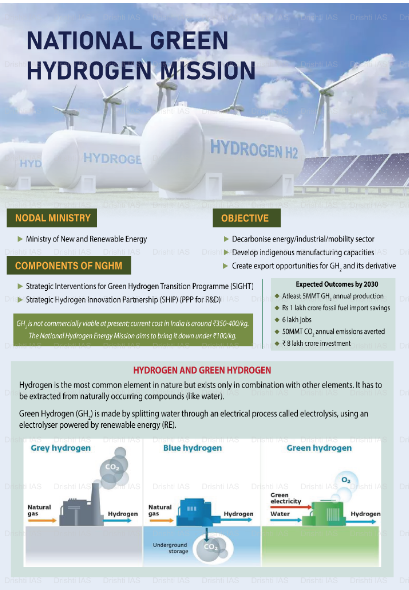MNRE Exempts Export-Oriented Green Hydrogen Projects from Domestic Solar Module Mandate to Lower Costs
(Source: Indian Express; Section: Economy; Page: 13)
| Topic: GS3 – Indian Economy |
| Context: |
| ● The Ministry of New and Renewable Energy (MNRE) has exempted export-oriented green hydrogen projects from its domestic solar module shortlist to lower costs and boost global competitiveness.
● This exemption allows projects to use cheaper imported solar modules instead of domestic ones, reducing production costs for green hydrogen. |
Analysis of News:
What is the National Green Hydrogen Mission (NGHM)?

- India launched the National Green Hydrogen Mission (NGHM) in January 2023.
- The Ministry of New & Renewable Energy (MNRE) is implementing the NGHM with a target to achieve a production capacity of 5 million tonnes per annum of Green Hydrogen in the country by the year 2030.
- The Strategic Interventions for Green Hydrogen Transition (SIGHT) programme, under NGHM, provides incentives for the manufacturing of electrolysers and the production of green ammonia.
- Under NGHM a dedicated portal was launched to provide information on the mission and steps for developing the green hydrogen ecosystem in India.
- India has also released scheme guidelines for the use of Green Hydrogen in steel, transport, and shipping sectors.
- The Department of Science and Technology has initiated Hydrogen Valley Innovation Clusters to foster innovation and promote the green hydrogen ecosystem in India.
Importance of Cost Reduction
- Lowering the cost of green hydrogen is essential to make it competitive with grey hydrogen, which is cheaper due to carbon-intensive production methods using natural gas.
- This cost reduction is critical to expanding green hydrogen’s demand globally and for India’s export market.
Solar Modules and Cost Impact
- Imported Solar Modules: 9.1 cents per watt (CIF basis, June 2024).
- Domestic Solar Modules: 18 cents per watt, making them twice as expensive as imports. The cost disparity between imported and domestic solar modules significantly influences the production cost of green hydrogen.
Impact on Domestic Industry
- MNRE Secretary Bhupinder S Bhalla emphasized that India’s fast-growing demand for solar modules will not be adversely affected by the exemption for green hydrogen projects.
Green Hydrogen Production Targets
- India aims to produce 5 million metric tons (MMT) of green hydrogen annually by 2030. Currently, 7.5 MMT of green hydrogen projects have been announced, and domestic demand is expected to replace grey hydrogen consumption.
Additional Incentives and Measures
- SIGHT Program: Rs 17,490 crore allocated for green hydrogen production and electrolyser manufacturing.
- R&D Investments: Rs 400 crore allocated, with 400 project proposals under review.
- Environmental and Transmission Incentives: Green hydrogen projects are exempt from prior environmental clearance and transmission charges for 25 years.
- Standards Development: 73 out of 100 recommendations for green hydrogen production and application have been notified by regulatory bodies, including BIS.
| What are the Reasons to Develop Green Hydrogen? |
| Reducing Greenhouse Gas Emissions:
● The primary reason for developing green hydrogen is to reduce greenhouse gas emissions and mitigate climate change. The use of fossil fuels for transportation and electricity generation is a major contributor to global emissions. ● Green hydrogen, produced from renewable sources, emits zero greenhouse gases, making it a sustainable and environmentally friendly energy source. Energy Security and Independence: ● Fossil fuels are a finite resource, and their prices can fluctuate due to global supply and demand. By developing renewable energy sources like green hydrogen, countries can become more energy-independent and less vulnerable to price shocks and supply disruptions. Creating New Industries and Jobs: ● The development of green hydrogen can create new industries and jobs, particularly in the renewable energy sector. The production, storage, and distribution of green hydrogen require specialized expertise and infrastructure, which can generate employment opportunities. ● According to the International Renewable Energy Agency (IRENA), the renewable energy sector employed 11 million people worldwide in 2018 and is expected to create more than 42 million jobs by 2050. Decarbonizing in Sectors which are Difficult-to-Decarbonize: ● The potential to substitute fossil fuels with green hydrogen is significant, especially in sectors that are difficult to decarbonize, such as heavy industry and aviation. These sectors contribute significantly to global emissions, and the use of green hydrogen can help reduce their carbon footprint. Technological Advancements: ● The development of green hydrogen can drive technological advancements and innovations in various sectors. The production, storage, and distribution of green hydrogen require new technologies and infrastructure, which can spur the development of new materials, processes, and systems. |
| PYQ: Hydrogen fuel cell vehicles produce one of the following as “exhaust” (2010)
(a) NH3 (b) CH4 (c) H2O (d) H2O2 Ans: (c) |
| Practice Question: Discuss the significance of the government’s policy to exempt export-oriented green hydrogen projects from domestic solar module requirements. How will this decision impact the production costs of green hydrogen and contribute to India’s renewable energy goals? (250 words/15 m) |
